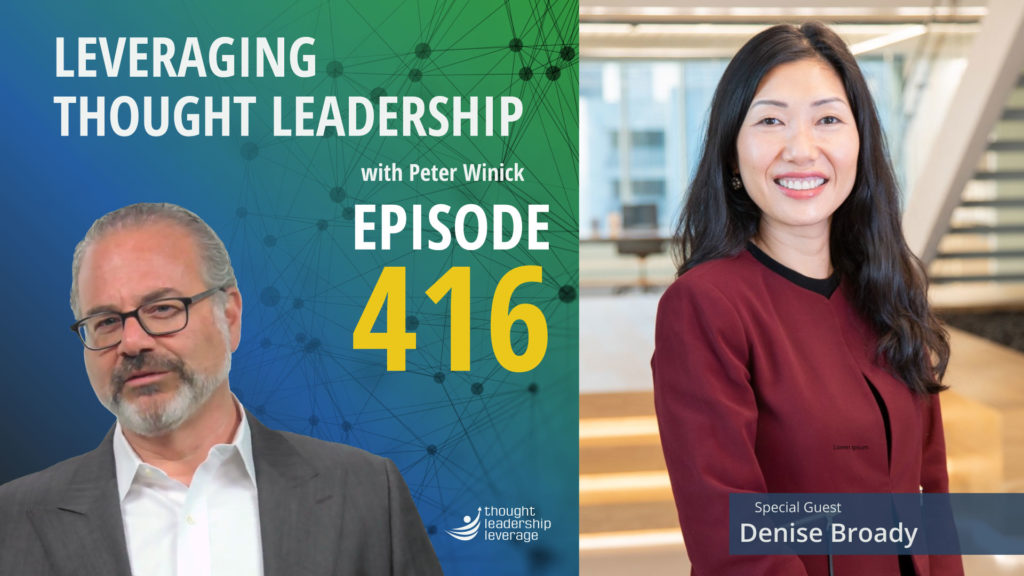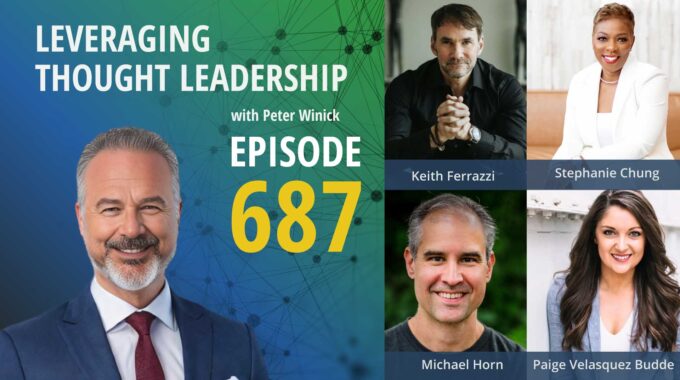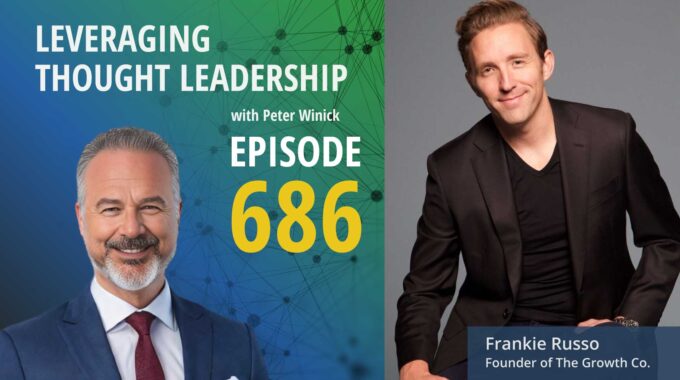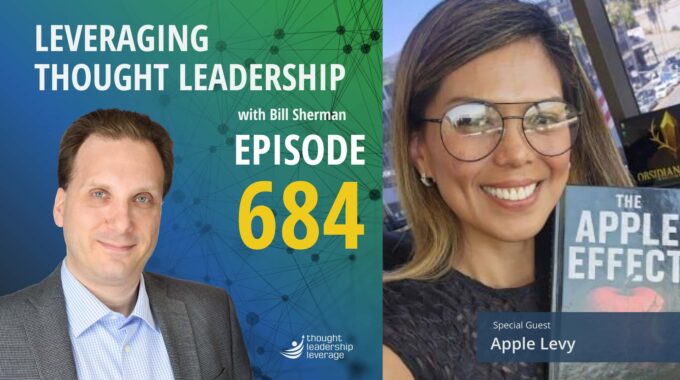Four practical frameworks to sharpen your message, market, and metrics This Best of 2025 compilation…
Accelerating Marketing Strategy with Thought Leadership | Denise Broady

Using thought leadership to tell your story and humanize your brand.
An interview with Denise Broady about partnering research with thought leadership to gain a wider reach.
How do you help a client integrate research into their thought leadership, and what are the benefits?
Enterprise software can be a complicated story to tell. To explore ways to humanize a complex brand or product, I’ve invited Denise Broady to share her expertise in research, thought leadership, and consulting. Denise is the Chief Marketing Officer at Appian Corporation, helping clients build apps and workflows with a low-code automation platform; combining people, technologies, and data in a single workflow to maximize resources and improve business results.
Our conversation begins with an active discussion of thought leadership’s ability to help tell a complex, enterprise story in a way that humanizes your brand. Denise shares how the lens of a business user can be used to create greater impact, preferring a personal touch and layman’s terms rather than complex, high-level terms that might not be understood by an audience.
Often, marketers feel the need to go it alone and control all aspects of their content’s delivery, but thought leadership doesn’t have to be a solo project. Denise shares how her co-sponsored research with The Economist is helping reach a global market, and how surveys on IT and business issues give her the information she needs to create thought leadership rooted in data – and bring solutions to the problems her audiences face.
Toward the end of our conversation, we examine ways to build a thought leadership team. Denise recounts a tale of starting with a task-force that grew as it brought on e dedicated people and found dedicated funding. Nobody approaches accounting as a part-time hobby, and thought leadership is no different. Without a dedicated team and reliable resources, thought leaders can’t be expected to develop the reach and cadence needed to effect significant change.
Three Key Takeaways:
- Choose your words carefully when explaining complex thought leadership; it’s critical that your audience understand, so speak in terms they will grasp easily.
- Creating co-sponsored thought leadership can create content with wider reach and a deeper, more informed perspective.
- Thought leaders coming from a marketing background can be tempted to use a marketing playbook – but think before you jump! Understand where your content fits in the cycle, and how to deploy it.
If you need a strategy to bring your thought leadership to market, Thought Leadership Leverage can assist you! Contact us for more information. In addition, we can help you implement marketing, research, and sales. Let us help you so you can devote yourself to what you do best.
Transcript
Peter Winick And welcome, welcome, welcome. This is Peter Winick. I’m the founder and CEO of Thought Leadership Leverage, and you’re joining us on the podcast today, which is Leveraging Thought Leadership. Today, my guest is Denise Brody. Denise is the CMO, chief marketing officer of Appian. She oversees marketing and communications, which is responsible for accelerating the marketing strategy and brand recognition across the globe. She has over 25 years of experience as a change agent and she is a two time published author. So one is a dummies book and one is a not dummies book. So there’s only two types of books in the world. There’s Dummies books and not-Dummies books.
Peter Winick So anyway, welcome aboard. Denise. Thanks for coming by today.
Denise Brody Thanks for having me, Peter.
Peter Winick So I’d love to start with maybe your condensed version of your journey as a thought leader and then maybe segway that into the use of thought leadership as a CMO at an organization. because both of those things are fascinating to me and the fact that it’s just about me. But why not? It’s interesting to me.
Denise Brody Yeah. So I think like in anything that you’re doing, whether you’re especially in B2B software, right? I just think that thought leadership gives you the opportunity to tell your story and it can be anything from humanizing the brand to creating ease of how to use your software as part of that. So I love the concept of always taking thought leadership and really grounding it into everything you do around your brand. And I think sometimes people get confused, right, because they think of product content as thought leadership or they think of a, you know, just because you publish a blog doesn’t mean it’s thought leadership is part of that. So I think the question is how do you tell the story so that your brand can be humanized as part of that process? Because for us, especially, like we’re in a great market, right? And we were the first ones from an AP and perspective to go to market from a low code site. And when you look at low code market, like not a lot of people even know what that means. Everybody knows web coding in Python or Java, what we call high code, but they don’t necessarily understand the nuance of low code.
Peter Winick So you just stay there for a minute because I think this is a perfect example of the content marketing folks would talk specifically about features, benefits, etc. of your software, which I’m sure is the greatest in the market. Right. But from a thought leadership perspective, the drum to beat is really low code, right? Which is not you know, there are others that might be in a low code universe, but if you start talking about what is the advantages of from a partnership lens of low code versus high code, by the way, the answer is still buy our software, but it’s a much it’s a much higher level conversation and one that doesn’t get tainted with the expectations of content marketing. So content marketing is great and there’s a place for it in the cycle, in the buying cycle and the sales cycle. But consistently talking about the power of low code in your example, I think that’s a great way to say what is the line for us between church and state, between content and thought leadership completely.
Denise Brody And I think that it creates an opportunity to, as I mention, you know, not only tell your story, but explain your market. And that is explaining is not about telling the product story. Explaining is why it’s advantageous to the users and our customers. Right? So for example, when you look at the market, the market, there is 37 million developers missing from now until 2026 to people, all the businesses in the world. And if you look at, you know, I was talking to one of our top banking customers and they told me explicitly, they said, look, for us to bring somebody that is high code into our environment. So let’s say you took a job, a developer. It will take them a year to be productive. In our environment, that’s expensive. And now with low code, we can bring on a college recruit, not even an experienced developer into our environment, and they are productive at three months. So that tells our stories. Yeah. And our wide perspective. Right. Ten times faster to develop a low code and build in low code, not code build. So you’re dragging and dropping pretty much that the piece that you want and we are building the code and the background for you as part of that. And then it’s a better experience not only for that for developers. So you still need to have like a STEM background or a coding background to be efficient and effective in coding. But you also have these business technologies that you’re able to bring into the overall umbrella. So now you could take a mechanical engineer or electrical engineer, right? That comes from a STEM background. And quickly teach them how to be productive in our environment. And I just think that we just did a great piece for my thought leadership on the state of low code developers. And what we did was we went out, we interviewed like 400 developers, mix of high code, low code. And what we really wanted to get to was what is their happiness? And sometimes working we don’t think about happiness but do low code developer or high code developers that learn low code. It’s not about eating the earning potential, but are they working on more strategic projects? Are they happier? And the shocking part was 83% of them came back and said not only did they have a higher earning potential, but they’re happier and happier.
Peter Winick If they’re happier, they’re more engaged, productive retention. So I want to go to sort of a half a step backwards to the other part of my initial question is your personal journey as a thought leader, right? You know, I was I was joking a bit at the front end that you did a dummies book in a non-dummies book. Tell it through the lens of you as a C level executive. The benefit to you and why, you know, you’ve got lots of things to do. You’re busy, a lot of demands on your time. Why have you consistently made the time over your career to invest in thought leadership? And how has it benefited you? Because, well.
Denise Brody I guess maybe it’s a journey. And the 25 years I spent, as you know, 15 out of 25, but I SAPI and you can imagine I see over 3000 products and sometimes it’s highly complicated to come in and go, oh, by the way, you know, when we started out it was ERP packages, right? So enterprise resource planning packages. And you explained that to somebody. I used to you know, my neighbors used to joke about it when I when they would see the car come pick me up at 430 in the morning to travel. They thought I worked at a travel agency. It was in my associated essay PE around the branding, like a Google or Microsoft. Right. Because when they’re on B2B.
Peter Winick Right.
Denise Brody Exactly. So enterprise software is a little bit more complicated to tell the story. So I always love thinking about a user, the business user, and telling the story through the lens of the business user. So when people would ask me, What did SJP do? I’m like, Oh, when you go to buy a can of Coke or Pepsi at a grocery store, there has to be inventory that gets managed by that, and that’s what I was doing in the background. So I think that if you tell the story and type leadership into through the eyes of the users, it has a different impact then let’s say for now, here’s, here’s what you ordered a cash does or procure to pay. Unless you’re in the business world, you have no idea what that needs.
Peter Winick Right. Which is nice. Well, not only not only are you in the business world, unless you’re in that side of not only your B2B, but unless you’re in tech enterprise sales, you would have no idea what that is. So I love the taking something really complex and the beauty of SAP is it’s invisible and making it visible to an audience.
Peter Winick If you’re enjoying this episode of Leveraging Thought Leadership, please make sure to subscribe. If you’d like to help spread the word about our podcast, please leave us a review and share it with your friends. We’re available on Apple Podcasts and on all major listening apps as well as at ThoughtLeadershipLeverage.com/podcasts.
Peter Winick I want to take this in a different direction for a moment or two. So pre-COVID, much of thought leadership playbook. From a marketing standpoint, I’m not saying this was you, but what I’ve seen sort of at a macro level was fairly simple let’s go find the top ten conferences and let’s either some combination of sponsorship and or getting our people to attend and speak at these conferences. And for the most part, we’d get a good outcome, right? So somebody else did the hard job of getting the market to Phenix or Las Vegas or Orlando or Chicago for three days. Let’s get our logo there. Let’s get our people. There are magical happen. And then we had COVID and we had two years, maybe three. Now, who knows without the number of events that we used to have. So that default part of the marketer’s playbook was thrown in the garbage. Now maybe it comes back, maybe it doesn’t hold on to that thought. But in a world absence or that was absent of events, where were you investing your thought leadership?
Denise Brody Yeah. We were heavily investing into co-sponsor restaurants with big outlets as well. Right. So like an economist of the world. And coming in and doing more of the bite size thought leadership so you could quickly consume it through paid media, whether that be through LinkedIn or other outlets. So there’s different ways to really think about what are the what’s the target. So during the pandemic, if you look at all the tech that in the projects were just mounting up as part of this. So we knew there was a tension between the business and the I.T. organization. So one of our big investments was to do a co-sponsor, a piece with The Economist, to go out and survey for locally to people, have these issues, get the data and then come back and tell the thought leadership story through the data and talking about what is i.t. What does the business really want and how i.t. is disrupting at this age and what can they do to align closer together? So it wasn’t.
Peter Winick Just stay there for a moment, then if we could show one, you know, there’s a collaboration piece because most marketers, particularly the thought leadership side, operate from a place where we’ve got to do this on our own. And now it’s a team sport, right? So you can partner with The Economist, you can fund research, and then you’ve got, you know, they bring the brand and they bring some exposure and all that, but you bring the thoughtfulness of it. That I think is a quite different approach from what it used to be. We want to control the venue, we want to control the stage, we want to control this to think who else can we partner with to get that message out there? And I love the idea of partnering with the research house, media play or whatever, very different playbook than Find Me the Ten Events and we’ll just pay for our logo there. What other tactics do you see bearing fruit in the current market and the world that we’re living in today?
Denise Brody Yeah, by the way, don’t forget, you’ve got a whole SMB community, whether it’s to leverage as part of this, one of our title pieces was around the four pitfalls of implementation, where we took our professional services chain and actually pooled all the best practices from the hundreds of projects they work in. And then for us is also partnering with through the ecosystem. So we have done thought leadership papers with Amazon, Accenture, some of the larger partners as part of this. And I think that coming together and being able to triangulate that branding as well as thought leadership is highly effective. And so it’s not just, you know, mining the content from your own SMEs, it’s also going to the ecosystem as part of this and of course, even the analyst community. Right. So it’s not just our SI partners or technology partners, it’s also the entire SI community as part of it.
Peter Winick So speak for a moment if you could or would on budgets moving forward, do you think now there’s going to be a different. Microscope, if you will, maybe telescope the budgets go under from a thought leadership perspective, you know, and how do you how do you make the case and defend the investments in thought leadership? Where’s the ROI and why do we why do we continue to spend and spend more?
Denise Brody Yeah, I think every company has the ebb and flow when it comes to investing, right? When you’re at a startup, for example, which I’ve been part of and turnarounds, you come in and you actually carve out a thought leadership team as well as also funding. As part of this, we ended up building at Appian an entire thought leadership team. It started as a task force and then we added dedicated resources to it. And then I actually gave them a dedicated fund as part of it. And then don’t forget about it. Since we’re leveraging the partner ecosystem, we have the ability to draw from a MTF, right? So a market development fund where there’s joint dollars to put into thought leadership. But I think you have to be super intentional in setting up not only funding, but also people. This is not a part time sport, right? It’s not like something that you think, oh, you do this like once a year. No, you need to have an entire editorial calendar. You need dedicated people. You need a process to work between the internal folks, the ecosystem, and then you need to really think about holistic funding and you need a combination. We didn’t even talk about this a little bit earlier, Peter, which is a new kind of hypothesis on something. When it comes about leadership, maybe it’s good to also poll and survey and get results of.
Peter Winick Sure, right.
Denise Brody And so these things become really important. And then there’s also the whole content production of it. So once you get the thought leadership can do you need bite size? Do you like a more extensive piece? How do you see entire thought leadership like we’ve done in the piece with The Economist? We have figured out how to use that for the entire year, not only the big piece, but then we cut it into specific industries like that.
Peter Winick So I call that repurposing, right? So how do you take anything that you do in thought leadership? And I think this is a critical piece. I love the fact that you’re advocating for dedicated resources because a lot of companies claim thought leadership is important to them. And then we’ll talk to them and say, well, tell me about the resources. Well, it’s sort of a volunteer thing or, you know, Denise does this for three weeks in April before she goes to South By or I’m like, Well, tell me about your finance function. Is that like a volunteer haphazard function? No, no, no, of course not. So I love the dedicated resource piece and I love the repurposing. Right? You do something in The Economist that is a treasure chest of assets to be repurposed in short form, video in shorter form, whatever the case may be. Any thoughts in general on how to avoid the temptation as a marketer, which this is a good thing to think, and marketers tend to think in terms of campaigns because that’s how we’re trained. What’s the campaign, what the margins are?
Denise Brody Or demand.
Peter Winick Yeah, yeah. Right. So thought leadership is a mid to long term play. It’s rarely a short term win. You can get some short term successes, but. You can’t apply campaign strategies and tactics against something that is not a campaign. So how have you wrestled that?
Denise Brody Yeah, I think for us, what’s really important is I always ascertain when we are creating that leadership content, is it for the top of the pyramid or towards the end of the funnel? So that classification becomes important. And I think that not everything is around the top of the funnel or has to be gated, right. So I think that again, because marketers are so tied to demand, it’s like, oh, that’s creative thought, leadership and gate everything. That is not always the case. I think you’ve got to figure out how media is content, how where do you put it in the funnel. And then we are lodging, for example. What we noticed is as we’re working on customer advisory boards and seeking our customers to the ambassador program, there was a constant asked, How do you set up a center of excellence for automation? And then, by the way, that became an entire thought leadership piece where we went out and we interviewed customers to get their best practices, and we launched a whole series around that. And by the way, we feel that that’s more of mid to end of the funnel because if you’re just starting to think about low code and AP and you’re not going to use that base for top of the funnel, it’s not something you’re thinking about, right?
Peter Winick So it’s putting it in the right in the right place against the right. I love the funnel segmentation because A, it’s speaking to the language that the organization from a marketing perspective already knows because there’s so much about thought leadership that’s different yet there’s so much that’s the same. Right? What is the purpose? It’s about awareness. It’s about you could use it to build your brand. You can use it for net new client acquisition. Where am I playing here? So I love that. So I want to thank you for your time today. This has been so insightful and so great and I appreciate you spending some time with us this afternoon. Thank you so much, Denise.
Denise Brody Thank you for having me. Thanks, Peter.
Peter Winick To learn more about Thought Leadership Leverage, please visit our website at ThoughtLeadershipLeverage.com to reach me directly. Feel free to email me at Peter at ThoughtLeadershipLeverage.com and please subscribe to Leveraging Thought Leadership on iTunes or your favorite podcast app to get your weekly episode automatically.






